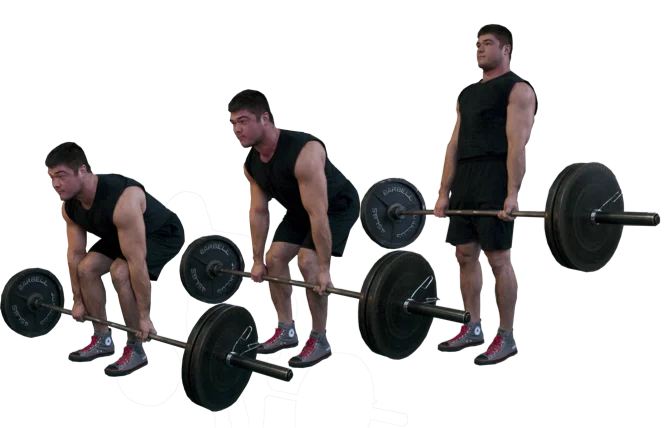Deadlift – Little Risky yet Best Exercise – IC Fitness Club
A deadlift is a strength training exercise that involves lifting a weight, typically a barbell loaded with plates, from the ground to an upright position with the hips and knees fully extended. It primarily targets the muscles of the posterior chain, including the glutes, hamstrings, and lower back, but also works the core, forearms, and upper back. Deadlifts can be performed in various styles, such as conventional, sumo, or Romanian, and can be modified to suit different fitness levels and goals. Deadlifts are considered one of the most effective exercises for developing overall strength and power.
Why Deadlift is Important?
Deadlifts are considered one of the most important exercises in strength training and weightlifting. Here are some reasons why deadlifts are important:
- Overall Strength: Deadlifts are a compound exercise, meaning they work multiple muscle groups at once, including the legs, back, core, and forearms. As a result, they are one of the most effective exercises for building overall strength.
- Posterior Chain Development: Deadlifts are particularly effective at targeting the muscles of the posterior chain, including the glutes, hamstrings, and lower back. Strengthening these muscles can improve posture, reduce the risk of injury, and enhance athletic performance.
- Functional Movement: Deadlifts are a functional movement, meaning they mimic the way we lift heavy objects in everyday life. By strengthening the muscles used in this movement pattern, we can improve our ability to perform daily activities safely and efficiently.
- Metabolic Conditioning: Deadlifts are a high-intensity exercise that can elevate heart rate and increase metabolic rate. Incorporating deadlifts into a workout routine can improve cardiovascular health, burn calories, and enhance fat loss.
How to Perform Deadlift
Performing a deadlift involves several steps. Here’s a general guide to performing a conventional deadlift, which is the most common type of deadlift:
- Begin by standing with your feet shoulder-width apart and the barbell on the ground in front of you. The bar should be positioned over the middle of your feet.
- Bend down and grip the bar with both hands using an overhand grip, with your hands slightly wider than shoulder-width apart.
- Lower your hips and engage your core muscles. Your back should be straight, your chest up, and your shoulders back and down.
- Begin lifting the bar by driving through your heels and extending your hips and knees. The bar should move up along your shins and thighs.
- As the bar reaches your knees, pull your shoulders back and squeeze your glutes to fully extend your hips.
- Pause briefly at the top of the lift, then lower the bar back to the ground by reversing the movement.
- As the bar passes your knees, bend your hips back and allow the bar to lower under control, maintaining a straight back and engaged core.
- Return the bar to the ground and release your grip.
It’s important to use proper form when performing deadlifts to avoid injury. Be sure to keep your back straight and engage your core muscles throughout the movement. It’s also important to start with a weight that you can lift with proper form and gradually increase the weight as you become stronger and more comfortable with the exercise.

Should we de-load the deadlift ?
Yes, it can be beneficial to deload the deadlift periodically as part of a strength training program. Deloading involves reducing the amount of weight lifted or taking a break from training altogether for a short period of time. Here are a few reasons why you might want to deload the deadlift:
- Injury Prevention: Deadlifts are a demanding exercise that put a lot of stress on the muscles, joints, and connective tissues of the body. Over time, this stress can lead to fatigue, inflammation, and even injury. Deloading can help to reduce the risk of injury by allowing the body to recover and repair.
- Plateau Breaking: If you’ve been doing the same deadlift routine for a while and have stopped seeing progress, deloading can help you break through a plateau. By giving your muscles and nervous system a break, you can come back to training with renewed strength and energy.
- Systemic Recovery: Deloading the deadlift can also help to improve overall recovery by reducing the demands on your body and allowing you to focus on other areas of your training or on rest and recovery.
The frequency and duration of deloading will depend on your individual training program and goals. As a general rule, it’s a good idea to deload every 4-8 weeks or whenever you feel fatigued or stuck in your progress. You can deload by reducing the weight you lift, performing fewer reps or sets, or taking a break from training altogether for a short period of time.
Deadlift and Functionality
The deadlift is a functional exercise that has many benefits for overall strength and fitness. Here are a few reasons why deadlifts are functional:
- Builds Full-Body Strength: The deadlift is a compound exercise that works multiple muscle groups at once, including the back, legs, and core. This makes it an effective exercise for building overall strength and improving functional movement patterns.
- Improves Posture: The deadlift targets the muscles that are responsible for maintaining good posture, including the erector spinae, glutes, and hamstrings. By strengthening these muscles, the deadlift can help to improve posture and reduce the risk of back pain.
- Enhances Athletic Performance: Many sports and activities require full-body strength and power, which the deadlift can help to develop. By improving your deadlift, you can improve your performance in activities such as running, jumping, and throwing.
- Increases Bone Density: Because the deadlift is a weight-bearing exercise, it can help to increase bone density and reduce the risk of osteoporosis.
- Improves Daily Functionality: The deadlift is a movement pattern that is used in many everyday activities, such as picking up heavy objects or bending down to tie your shoes. By improving your deadlift, you can improve your ability to perform these tasks with ease and reduce the risk of injury.
Overall, the deadlift is a functional exercise that can help to improve strength, posture, athletic performance, bone density, and daily functionality. It’s a challenging exercise that requires proper form and technique, but with proper training, it can be a valuable addition to any fitness program.





